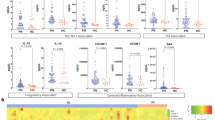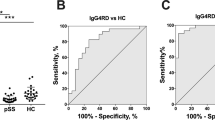Abstract
Although chemokines are critical elements for the selective attraction and activation of various leukocyte subsets in the inflammatory process, there are few findings concerning T helper (Th) 1 or Th2 chemokines in autoimmune blistering disease (ABD). To determine whether serum levels of chemokines that are preferentially chemotactic for Th1 (monokine induced by IFN-γ (MIG/CXCL9)) and Th2 (thymus and activation regulated chemokine (TARC/CCL17) and macrophage derived chemokine (MDC/CCL22)) cells were elevated and whether they correlated with the clinical features in patients with ABD. Serum chemokine levels were examined using ELISA in patients with pemphigus vulgaris (PV, n=19), pemphigus foliaceous (PF, n=14), or bullous pemphigoid (BP, n=27) and normal controls (n=20). Serum MIG levels were significantly higher in patients with PV, PF, or BP than those in the control subjects. Serum levels of TARC and MDC were also significantly elevated in patients with PV, PF, or BP relative to the normal controls. Among the ABD subgroups, the levels of each chemokine tended to be higher in BP patients than in PV patients. Furthermore, serum TARC levels correlated positively with serum IgE levels in patients with ABD. Levels of TARC, MDC, and MIG were significantly decreased after treatment when the skin lesions disappeared in these patients. Furthermore, serum MIG levels correlated positively with serum levels of TARC and MDC in the ABD patients. These results suggest that both a Th1 chemoattractant MIG and Th2 chemoattractants, TARC and MDC, cooperatively play a role in the development of ABD.




Similar content being viewed by others
Abbreviations
- ABD:
-
Autoimmune blistering disease
- PV:
-
Pemphigus vulgaris
- PF:
-
Pemphigus foliaceous
- BP:
-
Bullous pemphigoid
- IFN:
-
Interferon
- IL:
-
Interleukin
- Th:
-
T helper
- MIG/CXCL9:
-
Monokine induced by IFN-γ
- TARC/CCL17:
-
Thymus and activation regulated chemokine
- MDC/CCL22:
-
Macrophage derived chemokine
- Ab:
-
Antibody
References
Amagai M (1999) Autoimmunity against desmosomal cadherins in pemphigus. J Dermatol Sci 20:92–102
Amagai M, Klaus-Kovtun V, Stanley JR (1991) Autoantibodies against a novel epithelial cadherin in pemphigus vulgaris, a disease of cell adhesion. Cell 67:869–877
Ameglio F, D’Auria L, Bonifati C, Ferraro C, Mastroianni A, Giacalone B (1998) Cytokine pattern in blister fluid and serum of patients with bullous pemphigoid: relationships with disease intensity. Br J Dermatol 138:611–614
Arbesman CE, Wypych JI, Reisman RE, Beutner EH (1974) IgE levels in sera of patients with pemphigus or bullous pemphigoid. Arch Dermatol 110:378–381
Asbrink E, Hovmark A (1984) Serum IgE levels in patients with bullous pemphigoid and its correlation to the activity of the disease and anti-basement membrane zone antibodies. Acta Derm Venereol 64:243–246
Balashov KE, Rottman JB, Weiner HL, Hancock WW (1999) CCR5(+) and CXCR3(+) T cells are increased in multiple sclerosis and their ligands MIP-1alpha and IP-10 are expressed in demyelinating brain lesions. Proc Natl Acad Sci USA 96:6873–6878
Bernard P, Aucouturier P, Denis F, Bonnetblanc JM (1990) Immunoblot analysis of IgG subclasses of circulating antibodies in bullous pemphigoid. Clin Immunol Immunopathol 54:484–494
Bhol K, Natarajan K, Nagarwalla N, Mohimen A, Aoki V, Ahmed AR (1995) Correlation of peptide specificity and IgG subclass with pathogenic and nonpathogenic autoantibodies in pemphigus vulgaris: a model for autoimmunity. Proc Natl Acad Sci USA 92:5239–5243
Budinger L, Borradori L, Yee C, Eming R, Ferencik S, Grosse-Wilde H, Merk HF, Yancey K, Hertl M (1998) Identification and characterization of autoreactive T cell responses to bullous pemphigoid antigen 2 in patients and healthy controls. J Clin Invest 102:2082–2089
Chang M, McNinch J, Elias C III, Manthey CL, Grosshans D, Meng T, Boone T, Andrew DP (1997) Molecular cloning and functional characterization of a novel CC chemokine, stimulated T cell chemotactic protein (STCP-1) that specifically acts on activated T lymphocytes. J Biol Chem 272:25229–25237
Christophoridis S, Budinger L, Borradori L, Hunziker T, Merk HF, Hertl M (2000) IgG, IgA and IgE autoantibodies against the ectodomain of BP180 in patients with bullous and cicatricial pemphigoid and linear IgA bullous dermatosis. Br J Dermatol 143:349–355
Flier J, Boorsma DM, van Beek PJ, Nieboer C, Stoof TJ, Willemze R, Tensen CP (2001) Differential expression of CXCR3 targeting chemokines CXCL10, CXCL9, and CXCL11 in different types of skin inflammation. J Pathol 194:398–405
Godiska R, Chantry D, Raport CJ, Sozzani S, Allavena P, Leviten D, Mantovani A, Gray PW (1997) Human macrophage-derived chemokine (MDC), a novel chemoattractant for monocytes, monocyte-derived dendritic cells, and natural killer cells. J Exp Med 185:1595–1604
Helander SD, Rogers RS III (1994) The sensitivity and specificity of direct immunofluorescence testing in disorders of mucous membranes. J Am Acad Dermatol 30:65–75
Hertl M, Amagai M, Sundaram H, Stanley J, Ishii K, Katz SI (1998) Recognition of desmoglein 3 by autoreactive T cells in pemphigus vulgaris patients and normals. J Invest Dermatol 110:62–66
Kakinuma T, Nakamura K, Wakugawa M, Mitsui H, Tada Y, Saeki H, Torii H, Komine M, Asahina A, Tamaki K (2002) Serum macrophage-derived chemokine (MDC) levels are closely related with the disease activity of atopic dermatitis. Clin Exp Immunol 127:270–273
Kakinuma T, Wakugawa M, Nakamura K, Hino H, Matsushima K, Tamaki K (2003) High level of thymus and activation-regulated chemokine in blister fluid and sera of patients with bullous pemphigoid. Br J Dermatol 148:203–210
Kaneko F, Minagawa T, Takiguchi Y, Suzuki M, Itoh N (1992) Role of cell-mediated immune reaction in blister formation of bullous pemphigoid. Dermatology 184:34–39
Liao F, Rabin RL, Yannelli JR, Koniaris LG, Vanguri P, Farber JM (1995) Human Mig chemokine: biochemical and functional characterization. J Exp Med 182:1301–1314
Lin MS, Swartz SJ, Lopez A, Ding X, Fernandez-Vina MA, Stastny P, Fairley JA, Diaz LA (1997) Development and characterization of desmoglein-3 specific T cells from patients with pemphigus vulgaris. J Clin Invest 99:31–40
Lin MS, Fu CL, Aoki V, Hans-Filho G, Rivitti EA, Moraes JR, Moraes ME, Lazaro AM, Giudice GJ, Stastny P, Diaz LA (2000) Desmoglein-1-specific T lymphocytes from patients with endemic pemphigus foliaceus (fogo selvagem). J Clin Invest 105:207–213
Lin MS, Fu CL, Giudice GJ, Olague-Marchan M, Lazaro AM, Stastny P, Diaz LA (2000) Epitopes targeted by bullous pemphigoid T lymphocytes and autoantibodies map to the same sites on the bullous pemphigoid 180 ectodomain. J Invest Dermatol 115:955–961
Lucey DR, Clerici M, Shearer GM (1996) Type 1 and type 2 cytokine dysregulation in human infectious, neoplastic, and inflammatory diseases. Clin Microbiol Rev 9:532–562
Nakazawa M, Sugi N, Kawaguchi H, Ishii N, Nakajima H, Minami M (1997) Predominance of type 2 cytokine-producing CD4+ and CD8+ cells in patients with atopic dermatitis. J Allergy Clin Immunol 99:673–682
Nickel R, Beck LA, Stellato C, Schleimer RP (1999) Chemokines and allergic disease. J Allergy Clin Immunol 104:723–742
Paliard X, de Waal Malefijt R, Yssel H, Blanchard D, Chretien I, Abrams J, de Vries J, Spits H (1988) Simultaneous production of IL-2, IL-4, and IFN-gamma by activated human CD4+ and CD8+ T cell clones. J Immunol 141:849–855
Patel DD, Zachariah JP, Whichard LP (2001) CXCR3 and CCR5 ligands in rheumatoid arthritis synovium. Clin Immunol 98:39–45
Qin L, Quinlan WM, Doyle NA, Graham L, Sligh JE, Takei F, Beaudet AL, Doerschuk CM (1996) The roles of CD11/CD18 and ICAM-1 in acute Pseudomonas aeruginosa-induced pneumonia in mice. J Immunol 157:5016–5021
Qin S, Rottman JB, Myers P, Kassam N, Weinblatt M, Loetscher M, Koch AE, Moser B, Mackay CR (1998) The chemokine receptors CXCR3 and CCR5 mark subsets of T cells associated with certain inflammatory reactions. J Clin Invest 101:746–754
Riechers R, Grotzinger J, Hertl M (1999) HLA class II restriction of autoreactive T cell responses in pemphigus vulgaris: review of the literature and potential applications for the development of a specific immunotherapy. Autoimmunity 30:183–196
Romagnani P, Rotondi M, Lazzeri E, Lasagni L, Francalanci M, Buonamano A, Milani S, Vitti P, Chiovato L, Tonacchera M, Bellastella A, Serio M (2002) Expression of IP-10/CXCL10 and MIG/CXCL9 in the thyroid and increased levels of IP-10/CXCL10 in the serum of patients with recent-onset Graves’ disease. Am J Pathol 161:195–206
Salgame P, Abrams JS, Clayberger C, Goldstein H, Convit J, Modlin RL, Bloom BR (1991) Differing lymphokine profiles of functional subsets of human CD4 and CD8 T cell clones. Science 254:279–282
Sallusto F, Lenig D, Mackay CR, Lanzavecchia A (1998) Flexible programs of chemokine receptor expression on human polarized T helper 1 and 2 lymphocytes. J Exp Med 187:875–883
Sallusto F, Schaerli P, Loetscher P, Schaniel C, Lenig D, Mackay CR, Qin S, Lanzavecchia A (1998) Rapid and coordinated switch in chemokine receptor expression during dendritic cell maturation. Eur J Immunol 28:2760–2769
Sallusto F, Palermo B, Lenig D, Miettinen M, Matikainen S, Julkunen I, Forster R, Burgstahler R, Lipp M, Lanzavecchia A (1999) Distinct patterns and kinetics of chemokine production regulate dendritic cell function. Eur J Immunol 29:1617–1625
Stanley JR (1993) Cell adhesion molecules as targets of autoantibodies in pemphigus and pemphigoid, bullous diseases due to defective epidermal cell adhesion. Adv Immunol 53:291–325
Tedder TF, Steeber DA, Chen A, Engel P (1995) The selectins: vascular adhesion molecules. FASEB J 9:866–873
Teraki Y, Hotta T, Shiohara T (2001) Skin-homing interleukin-4 and -13-producing cells contribute to bullous pemphigoid: remission of disease is associated with increased frequency of interleukin-10-producing cells. J Invest Dermatol 117:1097–1102
Weng Y, Siciliano SJ, Waldburger KE, Sirotina-Meisher A, Staruch MJ, Daugherty BL, Gould SL, Springer MS, DeMartino JA (1998) Binding and functional properties of recombinant and endogenous CXCR3 chemokine receptors. J Biol Chem 273:18288–18291
Wu H, Schapiro B, Harrist TJ (2004) Noninfectious vesiculobullous and vesiculopustular diseases. In: Elder DE, Lever WF (eds) Lever’s histopathology of the Skin IX. Lippincott Williams & Wilkins, Philadelphia, pp 253–266
Zillikens D (1999) Acquired skin disease of hemidesmosomes. J Dermatol Sci 20:134–154
Zlotnik A, Yoshie O (2000) Chemokines: a new classification system and their role in immunity. Immunity 12:121–127
Acknowledgments
We thank Ms. M. Matsubara and Ms. Y. Yamada for technical assistance.
Author information
Authors and Affiliations
Corresponding author
Rights and permissions
About this article
Cite this article
Echigo, T., Hasegawa, M., Shimada, Y. et al. Both Th1 and Th2 chemokines are elevated in sera of patients with autoimmune blistering diseases. Arch Dermatol Res 298, 38–45 (2006). https://doi.org/10.1007/s00403-006-0661-5
Received:
Accepted:
Published:
Issue Date:
DOI: https://doi.org/10.1007/s00403-006-0661-5




